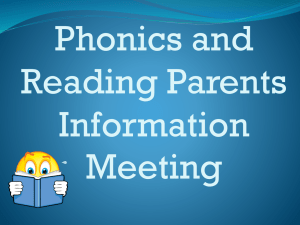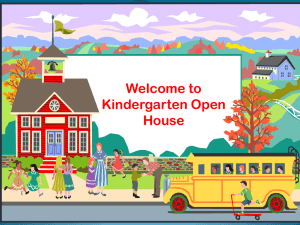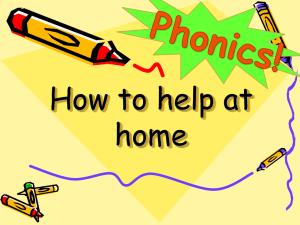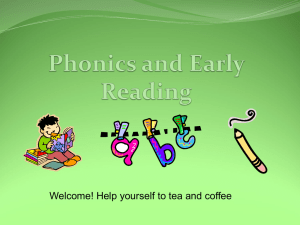Sound Safari
advertisement
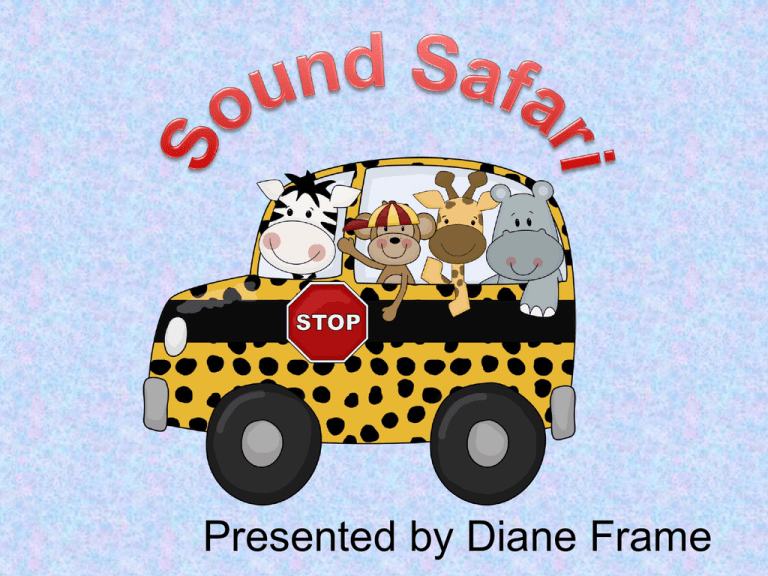
Presented by Diane Frame Phonological Awareness is Auditory Pre-K Kinder A sentence is made up of words. Orally separate a 4 word sentence into individual words A sentence is made up of words. Point/Clap/Count words in a sentence Syllables: combine/delete syllables into/from spoken words (pa+per=paper/ paperpa=per) Syllables: Identify syllables in spoken words (clap/move object for each syllable) Rhyme: Produce a word that rhymes with a given word (match rhyming pairs, rhyme in nursery rhyme) Alliteration: Produce word with same beginning sound as a pair of words big, blue) Rhyme: Orally generate rhyme in response to spoken words (what rhymes with hat?) Distinguish rhyme from non-rhyme (bat/hat vs bat/car) Alliteration: Recognize spoken alliteration (baby boy bounces ball) First Rhyme: Orally generate a series of original rhyming words using a variety of phonograms (ant/ake, bl,cl) Distinguish between long/short vowel sounds in spoken words (bit/bite) Recognize the change in a spoken word when a phoneme is added/changed/removed (cat/hat, hat/ham, ham/him) Phonological Awareness: provides a basis for phonics Pre-K Kinder Onset & Rime: combine onset and rime of a familiar one syllable word first using pictures, then without pictures Onset & Rime: Blend spoken onset and rimes to form simple words (cvc - /c/ + at) Phonemes: Child recognizes and blends two phonemes into real words with pictorial support (/k/ + /e/ = key) Phonemes: Blend spoken phonemes to form one syllable words (/m/ /a/ /n/) Isolate initial phoneme on one syllable spoken words (cat = /k/) Segment one syllable spoken words into 2-3 phonemes (dog = /d/ /o/ /g/) First Phonemes: Blend spoken phonemes into one and two syllable words including blends (/f/ /l/ /a/ /t/) Isolate initial/medial/final sounds in one syllable spoken words (cat= /k/ /a/ /t/) Segment one syllable spoken words into 3-5 phonemes (splat= /s/ /p/ /l/ /a/ /t/) How do we teach Phonological Awareness? Counting words in sente Concept of Word • Counters, students, fi Sentence segmentation: Whole Group: Smartboard, large word cards • words from poems, stories, big books, sight words • pocket charts, students Small Group: index cards, ipads, white boards, sentence strips (cut, then glue it back together) I can see the dog run. How do we teach Phonological Awareness? Syllables Whole group/Small group 1. Line up/release 2. Syllable sort in word work center 3. Names, picture cards, months/days of week 4. Vocabulary words 5. Sight words How do we teach Phonological Awareness? Bubble gum, bubble gum in a dish Rhyme How many pieces do you wish? Nursery rhymes, counting chants, counting out chants, jump rope rhyme (pretend, then use at recess), hink pink clues, Rhyme? Yes/No, Rhyme around the circle/table, Oops Wrong Rhyme This is my _____, Oops, no this is my _________! rose/nose pie/ eye pin/chin cheer/ear farm/arm 1, 2, 3, 4… How do we teach Phonological Awareness? Tongue Twisters:and other word play alliteration Sally sells seashells down by the sea shore. Use their names: David digs deep dark donut holes! Spoonerisms: sound switching Start with a funny name day: Is your name Randy Jones? No, Im Jandy Rones Then play games with them: Goys and birls, today is our dibary lay. Pig Latin: “ouyay, avhay a-ay oodgay ayday!” How do we teach Phonological Awareness? Phoneme Blending (auditory) First have them echo sounds you make: single sounds, double sounds, strings of sounds: /i/, /i/ /i/, /i/ /e/ /t/ (at teacher table they can move a bean, cube, or other manipulative from left to right to represent the sounds they echo) No letters yet! Next, blending with names: “I’m thinking of a friend, can you guess who…/v/ /er/ /o/ /n/ /i/ /k/ /a/” Finally, move to vocabulary words, theme words, or sight words. *Resource for higher or older kids needing to develop phonological awareness: Sounds Like Fun by Cecile Cyrul Spector Phonics: Sounds and Print are connected Pre-K Letters: Name 20 upper and 20 lowercase letters Sounds: Recognize 20 letter sounds Produce 10 letter sounds Kinder Letters/Sounds: Identify common sounds *consonants and vowels First Letters/Sounds: Decode words in context and isolation by applying common letter/sounds correspondence *consonants, vowels, blends, consonant digraphs, vowel digraphs, vowel dipthongs Combine sounds from letters and common spelling patterns (consonant blends, long and short-vowel patterns) to create recognizable words Use knowledge of lettersound relationships to decode regular words in text and independent of content (VC, CVC, CCVC, CVCC words). Use common syllabication patterns to decode words (VC, CVC, CCVC, CVCC, CVCe, CCVCe) Phonics: the relationship between letters/groups of letters and sounds Pre-K Kinder Recognize that new words are created when letters are changed, added, or deleted First Read base words with inflectional endings (plurals, past tenses) Decode words with common spelling patterns (-ink, -onk, -ick) Use knowledge of the meaning of base words to identify and read common compound words Identify and read contractions (isn’t, can’t). Identify and read at least 25 high- frequency words from a commonly used list. Identify and read at least 100 high- frequency words form a commonly used list. How do we teach Phonics? Letters and Sounds How do we teach Phonics? Blending Sounds Bumpy blending – sounds are distinctly separate or “choppy”. Can cause problems for many children. Smooth Blending – sounds are connected or “hooked together”. This is what we want! Model smooth blending! /s/ /u/ /n/ = sun What about those who struggle? Whole Group – using a set of large letters, have students stand apart saying their sounds, move closer together and say sounds quicker. Small Group – Phonics Phones, Say it/Move it, Bumpy/Smooth Ideas: take a breath first, sing the word, finger hook How do we teach Phonics? Segmenting Sounds Blending and Segmenting are two sides of the same coin. So much of what we do with language, reading and writing, works this way. We want children to see the connections. Just like we modeled smooth blending, we want to model smooth segmenting as well. sun = /s/ /u/ /n/ Activities: • Puppet Talk • Push the sounds • Bead slide • Ball toss – individual or partner • Push lights • Slinky • Rubber bands How do we teach Phonics? Sound Switching cat Sound Switching is about playing with sounds in words and recognizing where the switch happened. Start with two or three phoneme words. Can be auditory or visual Whole Group: Use letter cards on pocket chart or let children be specific letters you need, smartboard, white boards, etc. rat ran pan pin pit pot top How do we teach Phonics? Spalding http://youtu.be/SV0mqyNwESY http://youtu.be/PFswXxtqkuY How do we teach Phonics? Sight Words Interactive Sight Word Wall Rocket Book / Giraffe Book Kinesthetic Spelling – cheerleading, jump roping, swimming, motorcycle, jack in the box, catch/throw a ball, shaving cream, wiki sticks, stamps, magnetic letters, sand, etc. Resources www.heidisongs.com www.picturemereading.com www.leapfrog.com www.nellieedge.com Phonemic Awareness by CTP Oo-ples and Boo-noo-noos by Yopp Reading Readiness by Neuhaus Resources Books for Phonemic Awareness: Runny Babbit by Shel Silverstein A Huge Hog is a Big Pic by McCall and Keeler I’m Number One by Rosen Some Smug Slug by Edwards Hooway for Wodney Wat by Lester Zin! Zin! Zin! A Violin by Moss Alphabet Books and Dr. Seuss Books


